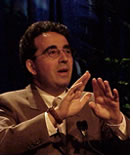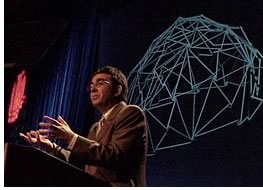
Awe-inspiring Work
Awesome! It's the only word to describe the presentation that architect-engineer-sculptor Santiago Calatrava delivered to the standing-room-only audience at the May 19 theme session, entitled, "Design Arts and Implementation." Calatrava presented images of his work—bridges, buildings, and sculptures—and explained the connections among and ideas behind these vehicles that he often uses to express a design concept in myriad forms.
 Calatrava
told the audience that he thought long and hard about what he could contribute
to a gathering of so many architects and decided that he would show images
of the major influences on his thinking and how he incorporates and permutates
concepts through incarnations of sculpture, bridges, and buildings.
Calatrava
told the audience that he thought long and hard about what he could contribute
to a gathering of so many architects and decided that he would show images
of the major influences on his thinking and how he incorporates and permutates
concepts through incarnations of sculpture, bridges, and buildings.
To illustrate one of the main drivers of his work, Calatrava began with images of a stark, white hilltown in the Mediterranean, which, he said, emphasized the contrast between the artificiality of building and the "naturality"of landscape. Villages such as this taught Calatrava the relation of the purity of form to light and shadow.
Calatrava next showed a conglomeration of his children's toys, assembled together into a sort of motion machine. Toys, he explained, work well to show how forces act and react. In turn, understanding forces helps one develop a materials vocabulary.
Movement
"The nature of movement will be the nature of the building,"
Calatrava declared. Many of his sculptures have moving parts, designed
to capture kinetic energy from the wind or, perhaps, from the push of
a hand. Many of his buildings have moving parts and, by their function,
are designed around user circulation and movement. In perhaps an even
purer form, many of his engineering works—particularly his bridges—exist
for the purpose of accommodating movement.
As an example of how a building's movement affects its nature, Calatrava presented images of the Kuwait Pavilion, created for the 1992 Expo in Seville, Spain, whose segmented roof pieces separate and the regroup to create a changing sculptural form against the sky.
"Research"
Calatrava explained how he often develops ideas for bridges and buildings
through his sculptures. In this way, the sculpture becomes "a research,
a model for the building," he said. He showed a large, metal sculpture
he had designed for the Museum of Modern Art—a gently swaying forest
of metal fronds that played with the hanging branches of surrounding trees.
To demonstrate the impact of context, he showed the same sculpture played
on a floating barge in Venice.
Human body
From the time of the ancient Greeks, artists have deployed "the measure
of man," Calatrava said., explaining how human proportion provides
design inspiration for the entities and components of his work-from pylons
to skylights. Further, the human form in movement and in motion often
provides Calatrava's design inspiration. He showed his famous Alamillo
Bridge in Seville, Spain, proportioned like a standing human figure and
poised like a spine, from which cables are suspended.
Bridges
"Both architecture and engineering are arts," said Calatrava,
reminding the audience that the two have been separate professions only
for the last 150 years. Calatrava's bridges, all reinforce the notion
of engineer/architect as artist, in the manner of Nervi and Saarinen.
His Lyon-Satola Airport -half bridge, half building-demonstrates the play
between symmetry and asymmetry while linking France's high-speed train
network to its new airport in Lyon. On a smaller scale, he created a small
arched bridge reflected perfectly in still water and serving as backdrop
to an ancient Roman arched span.
 Engineer
Calatrava also showed a number of spectacular European pedestrian bridges
bearing his singular sense of design, including the asymmetrically curved,
cable-stayed Camo-Volatin Bridge in Bilboa, Spain, and twin spans in Murcia,
Spain, built with a platform of laminated glass. "We have to think
about how important bridges are to communities," Calatrava said.
"They have incredible potential to revitalize cities." He believes
that the form and appearance of bridges have an enormous impact on people,
affecting their day-to-day movement, and, in a grander sense, the image
they hold of a particular place. Calatrava also explained that the last
half century in Europe changed forever the nature of bridges because World
War II destroyed so many of the bridges built before that time.
Engineer
Calatrava also showed a number of spectacular European pedestrian bridges
bearing his singular sense of design, including the asymmetrically curved,
cable-stayed Camo-Volatin Bridge in Bilboa, Spain, and twin spans in Murcia,
Spain, built with a platform of laminated glass. "We have to think
about how important bridges are to communities," Calatrava said.
"They have incredible potential to revitalize cities." He believes
that the form and appearance of bridges have an enormous impact on people,
affecting their day-to-day movement, and, in a grander sense, the image
they hold of a particular place. Calatrava also explained that the last
half century in Europe changed forever the nature of bridges because World
War II destroyed so many of the bridges built before that time.
Buildings
In the buildings portion of his talk, Calatrava explained the value to
him of sculptural research. The form of sculpture is purer, he said, because
it is not bound by a building's functionality. "The beauty of architecture,
though, is its penetrability," he said as prelude to discussing his
creations.
• BCE Place, a gallery in Toronto, which Calatrava proposed for the
space instead of a sculpture the client had originally called for.
• The Sondica Airport in Bilboa, which (in the spirit of Saarinen's
TWA terminal at JFK International Airport, New York City) recalls the
form of a bird in flight.
• The large-scale, multi-use Valencia City of Science, Valencia,
Spain, built in a dry riverbed, contains a number of exciting components
with moving parts, including the Glass Palace-like Palacio de les Artes
opera house, for which the entire roof span, like an eyelid, opens to
the sky.
• A design under way for a cathedral in Oakland, Calif. Its praying-hands
form in glass and steel replaces the 1890 St. Francis de Sales Cathedral
destroyed in the 1989 earthquake.
Words—written or spoken—cannot capture the essence of these projects. Interested architects should visit Calatrava Web site, www.calatrava.com.
Calatrava concluded with a video presentation of his work and creative process. Punctuated with dramatic string chamber music, the video gave dramatic proof of how movement flows in and around the sculptural magnificence of this master architect's work and how his ideas flow. The audience was enthralled. Despite the long overrun of the session, the architects were reluctant to see Calatrava depart and held him in place several minutes longer with a standing ovation.
Copyright 2001 The American Institute of Architects. All rights reserved.
![]()
|
Words—written or spoken—cannot capture the essence of these projects. Interested architects should visit Calatrava's Web site. |
|